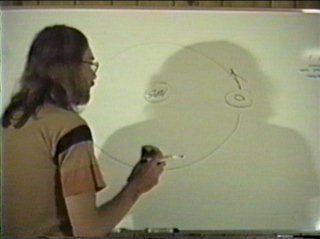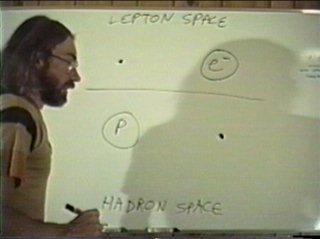Excerts from "Mirrors, Strings & Manifolds: The Geometry of Everything," C1994, Pg.4
Ether Drag and Nuclear Perspectives
 |
The Michelson-Morley experiment had to be addressed since I am essentially resurrecting the ether, albeit in a somewhat different and unexpected form. The idea of this experiment was to use an interferometer to detect the earths motion through space. The failure of this one experiment convinced physicists that there was no luminiferous ether. Various ideas were suggested at the time to explain why the ether was not detected, and one of these was the "ether drag" theory. Ether drag was scrapped as an explanation, as there was just no evidence for it other than the failure of the experiment. Well, I not only resurrect the ether, I also resurrect the ether drag theory. If the couriers of the charge force are depleted quanta, and space is composed of depleted quanta, then charge constitutes an ether wind. The experiment was therefore doomed to failure, because every particle that contains a quark participates in the charge interaction. The earth is a rather large body filled with quarks that are participating in the charge interaction. Even the particles in the interferometer will generate a charge wind. The result is an energy-density gradient around gravitating bodies, which implies ether drag as a rational consequence. (2008 NOTE: A consequence of this particular ether drag theory is something I call "ether zephyrs." If charge is enhancing the energy-density of space-time at short range, and gravity is diminishing the energy-density of space-time at long range, then there should always be an ether zephyr moving towards any gravitating body. This topic is covered more fully on the "String Basics" page.) |
 |
The perspective from which you view a particle has a lot to do with the way the particle appears to you. Viewing a hadron from lepton space would make the hadron appear point-like, as though it had no structure. The lepton viewed from hadron space appears point-like, but in its own domain of lepton space, it can display structure just as the hadron does in hadron space. Another conceptual way to illustrate this is to imagine a 1x1x2 box with a smoked glass partition dividing the box into two equal parts. This box represents the space-time manifold. The volume on one side of the glass partition represents lepton space, the other side represents hadron space. On one side of the partition you inflate a balloon so it just touches the glass. The side of the box you insert the balloon into determines whether the particle is a lepton or a hadron, because that is where the volume of the particle is located. Now if you build the box large enough so that you can climb inside of it, you will observe that the balloon is a large object with structure, provided you climb into the side of the box where the balloon locates its volume. But if you climb into the side of the box where the volume of the balloon is not located, all you can really see of it is the place where the balloon touches the smoked glass, and that point is rather small compared to the actual volume of the balloon. (2008 NOTE: I should have mentioned that the only portion of the proton that touches lepton space is the negative charge mirror of its down quark, and the only portion of the electron that touches hadron space is the positive charge mirror of its down quark.) |
Go Back Next Page